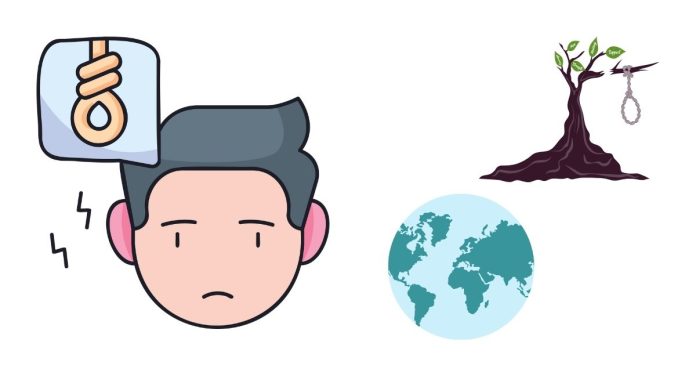Suicide is a deeply sensitive and serious topic that affects millions of individuals and families worldwide. The rate of suicide can be influenced by various factors, including mental health issues, economic instability, societal pressures, and access to mental health resources. While we may discuss statistics about suicide rates in different countries, it’s crucial to approach the subject with empathy and understanding. Suicide prevention, education, and support systems are essential in addressing this global issue.
Suicide rates are often measured per 100,000 people, and the following countries have some of the highest rates of suicide based on recent data. It’s important to note that these statistics can fluctuate year by year and may be influenced by various factors such as cultural norms, social support structures, and healthcare accessibility.
1. Lesotho
Lesotho, a small landlocked country in Southern Africa, has the highest suicide rate globally. In recent years, the country has seen alarming numbers of suicides, particularly among young people. Contributing factors include high unemployment, poverty, HIV/AIDS-related stigma, and limited mental health resources. Suicide prevention is a growing concern, and there is an increasing push for mental health awareness and support in Lesotho.
2. Russia
Russia has long struggled with high suicide rates, driven by a combination of social issues such as alcoholism, economic hardships, and mental health issues. In particular, middle-aged men are at high risk. Efforts to reduce suicide rates in Russia include improving healthcare access and addressing alcohol dependency. Despite these efforts, the issue remains pressing, with suicide prevention requiring more targeted strategies.
3. Guyana
This South American country ranks high on the list of countries with high suicide rates. The prevalence of suicide in Guyana is linked to factors like widespread poverty, limited mental health services, and the country’s history of social and economic instability. The use of pesticides as a method of suicide has been noted as a major contributing factor. Government and non-governmental organizations are working to raise awareness and improve mental health services.
4. South Korea
South Korea consistently ranks among the top countries with high suicide rates, despite its economic prosperity. The intense pressure to succeed academically and professionally, combined with high levels of societal expectation, mental health stigma, and an aging population, contribute to the country’s alarming suicide rates. The government has been implementing measures to address these issues, including increasing mental health services and suicide prevention programs.
5. Japan
Japan has a complex relationship with suicide, deeply influenced by its cultural history. While the country has made significant progress in reducing its suicide rates in recent years, it remains one of the highest globally. The primary causes of suicide in Japan include societal pressures, work-related stress, and mental health challenges. The government has stepped up its efforts to tackle this issue with suicide prevention programs and public health campaigns.
6. Kazakhstan
Kazakhstan’s suicide rate is among the highest in Central Asia, with alcohol abuse, social isolation, and poor mental health care playing key roles. Suicide rates in Kazakhstan have been notably higher among men, particularly in rural areas. The government has initiated suicide prevention campaigns and sought to improve access to mental health services, but challenges remain.
7. Belarus
Belarus, located in Eastern Europe, has one of the highest suicide rates globally. Economic instability, social discontent, and mental health challenges are major contributing factors. The high rate of alcoholism and lack of comprehensive mental health support systems exacerbate the problem. Efforts to reduce suicide rates are being made through government interventions, including reforms in healthcare and mental health awareness.
8. Sri Lanka
Sri Lanka’s suicide rate has been one of the highest in South Asia, although it has declined significantly in recent years. The use of pesticides as a method of suicide has been a major issue, particularly in rural areas. The government has implemented bans on certain pesticides and has made efforts to improve mental health care, but suicide prevention remains a critical concern.
9. Lithuania
Lithuania, a Baltic country, has one of the highest suicide rates in Europe. Factors contributing to the high suicide rate include economic challenges, particularly following the collapse of the Soviet Union, as well as social isolation, alcohol abuse, and mental health issues. The country has made strides in mental health care, but challenges remain in addressing the underlying causes.
10. Hungary
Hungary has one of the highest suicide rates in Europe, influenced by a combination of social, cultural, and psychological factors. Alcohol abuse, economic hardship, and mental health issues are among the key contributing factors. The Hungarian government has worked to improve mental health services and increase awareness of suicide prevention, but there is still much work to be done.
The Importance of Suicide Prevention
The high suicide rates in these countries highlight the critical need for increased awareness, prevention, and intervention strategies. Governments and non-governmental organizations worldwide are working to improve mental health resources, reduce stigma, and address the root causes of suicide.
Mental health care, community support, and education about suicide prevention are essential in lowering suicide rates globally. Creating safe spaces for people to talk about their struggles, providing access to mental health services, and developing targeted interventions can save lives.
While these countries face serious challenges in combating suicide, there is hope. Increased awareness, improved healthcare systems, and more open discussions about mental health can make a difference in reducing suicide rates. It is essential for society to come together, offering support to those struggling with mental health issues and ensuring they have access to the resources they need to heal.
If you or someone you know is experiencing thoughts of suicide, please reach out to a trusted friend, family member, or mental health professional. There is always help available, and recovery is possible.


